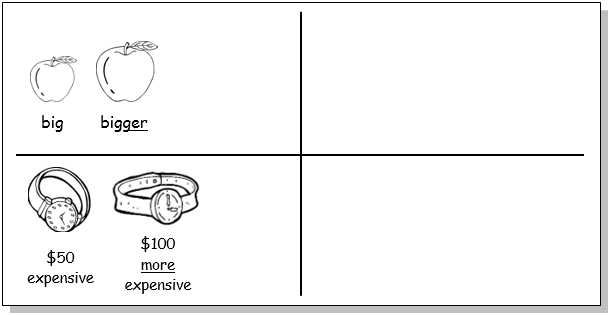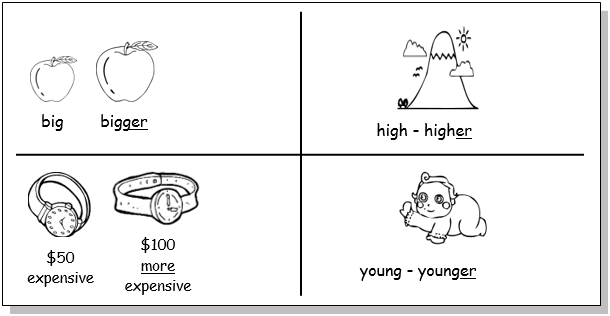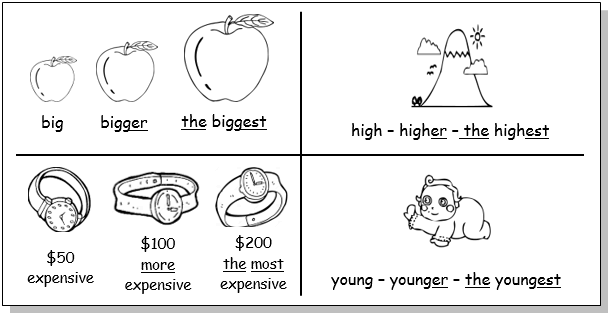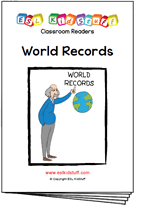Menu
Download the accompanying materials to this lesson plan - sign up here
Resources and materials for ESL Kids teachers
A superlative adjective compares three or more nouns and shows the noun with the highest degree. For example, “Mount Everest is the highest mountain in the world”. This compares all of the mountains in the world and shows that Mount Everest if the highest of the lot.
Superlatives take the following forms:
This lesson will help your students describe the world around them and make comparisons. This lesson should be taught after the Comparing Things (Comparative Adjectives) lesson as much of that lessons vocab will be recycled.
See our "Warm Up & Wrap Up" page.
1. Review adjectives – play “Pictionary”
In the last lesson (comparative adjectives) students learned a lot of new adjectives. Let’s review these by using the word cards from last lesson (you can also find these cards at the end of the printable lesson plan – there are two extra cards: high and young – don’t use these yet).
Before class get a set of word cards from last lesson or cut out the word cards at the end of this lesson plan.
You are going to play “Pictionary” on the board with the whole class. Select a card but don’t show anyone. Look at the adjective and then draw a picture to represent it on the board. For example, if the word is “tall”, draw a tall tree. Get students to call out until someone says the adjective … you may need to help a bit (e.g. indicating the tree is TALL by drawing a small person at the bottom).
The person who shouted out the right answer gets to come to the board, select a card and draw a picture. Play until all of the cards have been used.
2. Review comparatives and teach two new adjectives
Clean the board. Draw lines to divide the board into 4 squares (see below). Draw an apple in the top-left square and elicit the word “apple”. Then draw a bigger apple next to the first apple. Under the first apple write “big” and say “This apple is big”. Then point at the 2nd apple and say “But this apple is …” and elicit “bigger”. Write “bigger” under the second apple.

Then do the same in the bottom-left square for the adjective “expensive” (and “more expensive”) using a picture of a watch.
Next, using the word cards from the Pictionary game, randomly say an adjective (e.g. “beautiful”). Students need to slap their desks with their hand if they know the comparative form (e.g. “more beautiful”). Ask the first student who slapped his/her hand for the answer and award 1 point if correct. Play until all the adjectives have been used – the student with the most points gets a round of applause.
Finally, let’s teach two new adjectives: high and young:
In the top-right square of the board, draw a mountain. Elicit “mountain” and teach/elicit “high” and write it under the mountain. Chorus “high” 3 times. Then elicit the comparative form “higher” and write this under a higher mountain – chorus 3 times.
In the bottom-right square, draw a baby. Ask the class “Is the baby old?”. Elicit/Teach “young”, write it on the board and chorus 3 times. Then elicit “younger”, write on the board and chorus 3 times. Your board will now look like this:

3. Play “Comparative Cards Spin the Pencil”
Before class print out enough of the card sets from the bottom of the printable lesson plan so that each group of 3-4 students has a set of cards.
Put students in groups of 3-4 around a table and put the set of cards face down on the table. Student A takes a card and reads the adjective to the rest of the group. He/She then takes a pencil and spins it on the table. When the pencil stops spinning the person who it is pointing at must say a sentence using the adjective on the card in the comparative form, for example:
You should model this with one group to the rest of the class so that everyone fully understands the game. It is worth writing the sentences from the model on the board so that students have a structure to follow.
As the game is being played, write down sentences you hear on the board (some correct and some with mistakes). When everyone has finished, bring everyone’s attention to the board. Read out the first sentence and ask if it is correct or not. If it is correct, put a check (✓) next to it. If it is wrong put a cross (X) next to it. Then have the groups discuss how to correct the mistakes and finally report back to the teacher to correct on the board.
4. Teach superlative adjectives (the adj+est / the most + adj)
Go back to the board from point 2. In the apple square draw a 3rd apple, bigger than the other two. Say “This apple is big. This apple is bigger. This apple is the biggest!”. Then write “the biggest” under the 3rd apple. Chorus three times.
Then do the same with the other three squares as below. Your board will look like this:

5. Do the "Comparatives & Superlatives" worksheet
Give out the "Comparatives & Superlatives" worksheets and have students fill them in, drawing and writing their ideas.
Start by showing what to do, for example, first point out the "taller" and “the tallest” trees and words in the first row, then model writing "smaller" and “the smallest” as well as drawing smaller men.
As students are working on their worksheets circulate and help out. When everyone has finished, go through the worksheet by eliciting and writing the answers on the board.
6. Students test each other on comparatives and superlatives
Place students in pairs. Student A looks at his/her "Comparatives & Superlatives" worksheet and Student B turns over his/hers. Student A starts by giving a short sentence with the adjective and Student B says the comparative and superlative forms, for example:
Student A: An old book.
Student B: An older book. The oldest book.
Student A: A beautiful bird.
Student B: A more beautiful bird. The most beautiful bird.
Pairs change roles after completing the test.
Finally, have all students turn over their worksheets and stand up. For each student, say a sentence with an adjective and that student to change your adjective example into a comparative and superlative. They can sit down if they give a correct answer. For example:
Teacher: David, a cheap car.
David: A cheaper car. The cheapest car.
Teacher: Good job! You can sit down.
7. Play "Let's compare things on the table"
Put students into groups of 3 or 4 and have them sit around a table. Start by modeling the activity with a group. Choose an object that all the students have, such as a pencil, pen, pencil case, bag, cell phone, shoe, notebook, etc. and get each student to place one of theirs on the table. Then students compare their objects, for example:
Student A: (pointing) A colorful pencil case.
Student B: (pointing) A more colorful pencil case.
Student C: (pointing) The most colorful pencil case!
Have the groups use as many items as possible as they practice. Walk around the room and help out with vocab and mistakes.
Finally, have each group present one of their conversations to the class.
8. Read classroom reader "World Records"
 This reader helps to reinforce the vocab and structures practiced in the previous activities. Before class, download and print off the reader "World Records". As you go through each page, have students guess the answers to each question before letting them see the picture (as the picture will have the answer!), for example:
This reader helps to reinforce the vocab and structures practiced in the previous activities. Before class, download and print off the reader "World Records". As you go through each page, have students guess the answers to each question before letting them see the picture (as the picture will have the answer!), for example:
Teacher: (reading from page 2) “First up, which is the fastest land animal in the world?”
Students: A horse? A tiger? etc.
Teacher: Hmm. Let’s see. (reading) “The answer is ... the cheetah!”. Wow, really! (Showing the picture on page 3). I wonder how fast it runs? Any ideas?
Students: 100 km/h?
Teacher: (reading) “The cheetah can run at a top speed of 120 km/h (75 mph), which is super fast!”. Wow, that is fast, isn’t it? That’s how fast I drive my car on the highway!”
etc.
At the end of the reader there is a quiz. You can do this as a whole class or in teams.
---
Alternatively, watch our video version of the reader (Internet connection required):
9. Do the "Class Superlatives Survey"
Give out a “Class Superlatives Survey” sheet to each student and have everybody stand up and mingle to write the names of students on their surveys. If you have a large class you can split into groups of 8-10 students to do their surveys. The activity may get a bit hectic but it will be great fun as students decide on important questions such as who has the biggest smile and is the fastest speaker.
At the end of the activity, collate all of the induvial survey answers to decide which student wins the popular vote for each category.
1. Assign Homework: "Compare Monsters" worksheet.
2. Wrap up the lesson with some ideas from our "Warm Up & Wrap Up" page.
 Found a mistake?
Found a mistake?
Please let us know
Full access to all resources on ESL KidStuff including lesson plans, flashcards, worksheets, craft sheets,
song downloads, classroom readers, flashcards app and songs app.